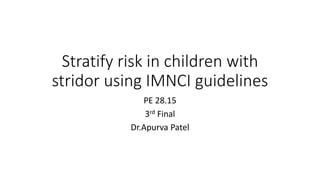
stratify risk in children with stridor using IMNCI guidelines.pptx
- 1. Stratify risk in children with stridor using IMNCI guidelines PE 28.15 3rd Final Dr.Apurva Patel
- 2. Brief overview of stridor • Stridor is a high-pitched, often noisy respiratory sound resulting from turbulent airflow through partially obstructed airways, typically in the larynx or trachea. It is commonly heard during inspiration but can occur throughout the respiratory cycle. Stridor may indicate underlying airway obstruction, and its severity can vary from mild to severe, necessitating careful evaluation to identify the underlying cause. Common etiologies include infections, congenital anomalies, foreign body aspiration, or inflammation. Timely assessment and management are crucial to address the underlying issues and ensure proper respiratory function.
- 3. IMNCI AND ITS RELEVANCE • IMNCI, or Integrated Management of Neonatal and Childhood Illness, is a comprehensive strategy developed by the World Health Organization (WHO) and UNICEF to address the major causes of childhood morbidity and mortality. Its relevance lies in its holistic approach to managing common childhood illnesses, emphasizing integrated care for both newborns and young children. • • Key points of relevance for IMNCI include: • 1. Holistic Approach: • 2. Early Identification • 3. Community-Based Care • 4. Simplicity and Feasibility • 5. Prevention and Promotion • 6. Training and Capacity Building • 7. Global Impact • In summary, IMNCI is relevant due to its holistic and community-centered approach, aiming to improve the overall health and well-being of children, especially in low-resource settings.
- 4. Criteria for assessing severity in stridor 1. **Sound Characteristics:** - Evaluate the pitch, loudness, and quality of the stridor. High-pitched and loud stridor may indicate more severe obstruction. 2. **Breathing Pattern:** - Observe the child’s overall breathing pattern, including the presence of retractions, nasal flaring, and increased respiratory rate. 3. **Cyanosis or Pallor:** - Check for signs of inadequate oxygenation, such as cyanosis (bluish discoloration) or severe pallor. 4. **Activity Level:** - Assess the child’s activity level and ability to feed. Increased distress during feeding or reduced activity may suggest more severe stridor.
- 5. 5.**Positional Changes:** - Observe if the stridor changes with the child’s position, such as worsening when lying down. This may indicate dynamic airway obstruction. 6. **Feeding Difficulty:** - Consider any difficulties in feeding, as this can be indicative of increased respiratory effort and severity of stridor. 7. **History of Stridor Episodes:** - Inquire about the frequency, duration, and progression of stridor episodes. Sudden onset or worsening may suggest a more urgent situation. 8. **Associated Symptoms:** - Take note of any associated symptoms, such as fever or signs of respiratory distress, which can contribute to assessing severity.
- 6. Factors contributing to risk stratification 1. Clinical Presentation 2. Respiratory Distress 3. Age of the Child 4. Underlying Etiology 5. Duration and Progression 6. Positional Changes 7. Vital Signs 8. Feeding Difficulties 9. Past Medical History 10. Response to Interventions
- 7. Stratify risk in children with stridor using imnci guidelines 1. **High Risk:** - Severe stridor at rest. - Signs of respiratory distress (e.g., retractions, nasal flaring). - Cyanosis or severe pallor. 2. **Moderate Risk:** - Moderate stridor with mild respiratory distress. - Presence of fever. - Abnormal vital signs (e.g., tachypnea). 3. **Low Risk:** - Mild stridor without respiratory distress. - No signs of distress at rest. - Absence of alarming associated Symptoms
- 8. Management of stridor according to risk 1. **High Risk:** - **Immediate Referral:** Children with severe stridor, signs of respiratory distress, or cyanosis require urgent referral to a higher level of care. - **Secure Airway:** In some cases, immediate airway management, such as intubation, may be necessary. 2. **Moderate Risk:** - **Hospital Admission:** Children with moderate stridor and respiratory distress may need hospital admission for close monitoring and further evaluation. - **Oxygen Therapy:** Provide supplemental oxygen to maintain adequate oxygen saturation. 3. **Low Risk:** - **Observation and Supportive Care:** Children with mild stridor and no significant distress can often be managed with observation and supportive care. - **Monitor and Reassess:** Regularly monitor the child’s clinical status and reassess as needed. Provide hydration and comfort measures.
- 9. 4. **Causative Treatment:** - **Identify and Treat Underlying Cause:** Regardless of risk level, address the specific underlying cause of stridor. This may include antiviral medications for viral infections, antibiotics for bacterial infections, or bronchodilators for conditions like croup. 5. **Educate Caregivers:** - **Caregiver Education:** Educate caregivers about signs of worsening stridor, when to seek medical attention, and any necessary home care measures. 6. **Follow-Up:** - **Scheduled Follow-Up:** Schedule follow-up appointments to monitor the child’s progress and ensure resolution of stridor.
- 10. Thank you